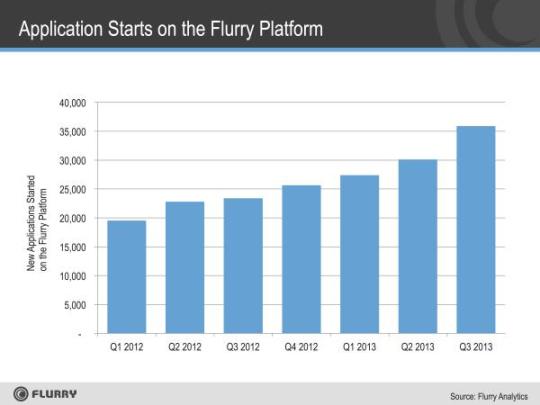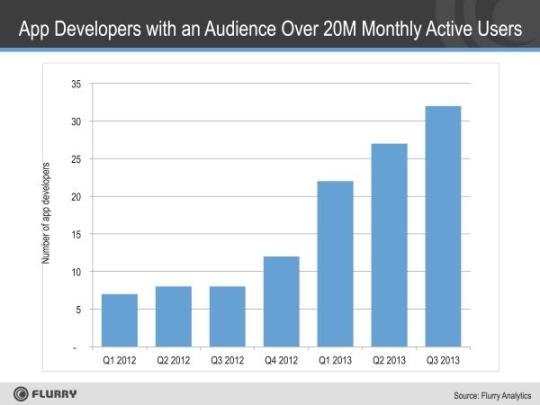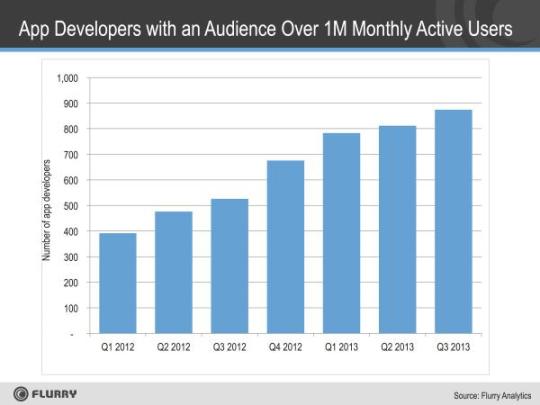In October of 2013, Softbank Capital made a $1.5B USD investment in Supercell, the maker of two successful mobile games, giving Softbank a 51% ownership of the game maker. This investment caught the world’s attention. It wasn’t just the rich $3B USD valuation Softbank placed on Supercell that intrigued onlookers, but more the speculation that Softbank and its CEO Masayoshi Son were onto a bigger trend. Mr. Son has a solid track record in anticipating big shifts in worldwide markets in general and the tech industry in particular. In the mid-nineties Softbank was a publishing powerhouse. By the mid 2000s the company became an Internet powerhouse. Today, Softbank is the third largest wireless carrier in the world. So what does this investment signal about the big shift that Mr. Son is anticipating? At Flurry we believe he is placing bets on the Mobile Content Explosion that is taking place around us.
At Flurry, we have always looked at the applications being started on our platform as a leading indicator of the app economy’s health. This is very similar to how U.S. economists treat housing starts as a leading indicator for the national economy. Typically, developers engage with Flurry and start applications on our platform a couple of months before they list them on App Stores. So if the activity on Flurry increases, it signals that more apps (and content) will be available on the stores within a couple of months.
Looking at application starts on the Flurry network since January 2012, we see an increase in the quarterly growth rate. This is in stark contrast to theories that the app ecosystem is congested. In fact, in just over 18 months, the rate of which new apps are being started on the Flurry network has nearly doubled as shown in the chart below.

While Flurry’s market share in analytics could have increased, we don’t believe it is the major factor in the acceleration of applications starts. Instead, we believe that we have entered a new phase of mobile content explosion, driven by rapidly changing consumer behavior. Over the last two years, application developers and media companies have seen the shift from personal computers to smart mobile devices including phones and tablets that are now in the hands of over 1.2 billion people worldwide. They have also seen the wild and global success of gaming, utility and messaging applications such as LINE, Kakao, Snapchat and WhatsApp. They are simply acting accordingly. With the hopes of reaching these 1.2 billion people with a press of a button, app developers and media companies are building mobile apps like never before.
Pundits have criticized the increasing number of apps and have often claimed that while there are millions of apps out there, very few are being used. They also claim that a few app developers have the lion share of usage, especially in the United States and other mature markets such as Japan and South Korea. Earlier this year, a report from Comscore claimed that Facebook (and Instragram) accounted for 26% of all times spent on mobile. In its latest earnings reports, Facebook’s COO Sheryl Sandberg almost confirmed Comscore ‘s numbers and claimed that Facebook’s share of people’s time is larger than that of YouTube, Twitter, Tumblr, Snapchat, LinkedIn, AOL and Yahoo combined. While Facebook’s reach and percentage of time spent are in a league of their own, there appears to be plenty of whitespace for others. In fact, just on the Flurry platform the number of independently owned app developers that have a worldwide audience of over 20 million Monthly Active Users (MAU) has jumped from 7 in Q1 2012 to 32 in Q3 2013. That is whopping 357% growth in 18 months.

In the same period, the number of app developers with an audience over one million MAU has risen from just under 400 to 875, a whopping 121% growth.

These numbers are simply unprecedented, especially because most of these app developers have risen organically, and not as a result of consolidation or through mergers and acquisitions. If anything, the market, its reach and the time spent on mobile is still with the “middle class”, or the mid-tail developers and content owners. Among the 1.2 billion device owners, app developers are finding millions of people to enjoy their apps and the content behind it.
Flurry’s numbers, which show the fast rise of app developers with large audiences, seem to indicate that worldwide, consumers with smart devices are still hungry for apps and mobile content, and app developers are building at increasing rates to feed this demand. We believe that once again, Softbank’s Masayoshi Son could once again be onto something really big.